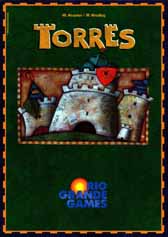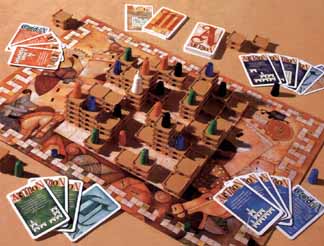
|
| Courtesy of Funagain Games |
Each player moves sequentially, spending up to 5 action points in making a move. At the end of a round, the board is scored, and each player moves their score marker on the victory point track around the edge of the board. The most basic score results from occupying a castle in which case you score the area of the base of the castle times the height of your highest knight. For example, a knight on the 3rd level of a castle with a base of 8 pieces will earn you 24 points ( 3 times 8 ). The highest score wins the game.

|
| Courtesy of Funagain Games |
The joy in this game comes from spending your 5 action points wisely, maximizing your score, and blocking other players. To expand a castle by one piece costs 1 action point. Players are limited to placing up to 3 castle pieces per turn, and there is a schedule of the number of available castle pieces per turn based on the number of players in the game. A handy card summarizes this for each player. Castle pieces may be placed on the 8 by 8 board to expand a castle horizontally or vertically, but a move may not merge two castles into one. Thus there are blocking moves to limit the growth of castles. Soon the board becomes crowded as the castles grow and near each other.
To score points for a castle, your knights must occupy it. To place a knight on the board costs 2 action points. Moving a knight costs 1 action point per space. A knight may jump any number of levels downward, but is limited to just one upward space per move. Players learn to block other knights by building skyward and forcing other knights to face a two step leap. It is possible to construct the castle in a stairstep fashion such that your opponents are always one step below you. Castles also facilitate knight movement by allowing knights that enter one level to exit on any door of the same level at the cost of 1 action point. So assume a castle is 1 piece wide by 6 pieces long, a knight will be able to enter the castle and exit 6 squares away for a cost of 1 action point. That helps you make a raid in far flung spaces on the board.
Another option on your turn is to buy an action card for 1 action point. These cards break the above rules by allowing you to do such things as: spend 6 or 7 action points in a turn, jump 2 spaces high, place a castle piece below a knight, enter and exit any door in the castle. You may only play one action card per turn, but these rule-breakers are often the key to making fancy and high point scoring moves. There are several rules for selecting the action cards: random, partially random, or non-random. I suggest players use the non-random method where you see all of your action cards and you buy whichever one is available. This makes the game more thought provoking and less dependant on the luck of the draw.
The last option is to burn your action points to move your marker up the victory point track. Since no two markers may occupy the same position on the victory point track, this is most useful when you wish to hop over an opponent's marker. It is also useful late in the game when the score is close and you have no useful move to perform. Not exciting, but useful.
For advanced players, there are optional cards that add extra methods of scoring. For example, knights forming certain patterns on the board will score additional victory points. These cards are fine window dressing if you become bored withe the basic rules of the game. Not necessary, but worth a few surprise laughs.
Our game group quickly went from beginning to master players. The rules are easy to master because your options are the same every turn. One downside of this game is that the moves are made sequentially and you really cannot plan your move until the player before you has completed. So there is downtime waiting for your turn. Another related criticism of the game is the tactical feel. Since you are always playing off the other player's moves, there is not much long term planning. Each player maximizes their score for the current move and that's it. I don't view these as major problems because the growth of castles makes the game develop quite nicely in my eyes.
The game works equally well with 2, 3 or 4 players. In fact, other than limitations in downtime, board size, and piece availability, the game would also work well with more than 4. Two sets may be combined for larger games with more people, although the downtime will be greater. Unlike Manhattan, another 3 dimensional 4 player game, there is not so much tit-for-tat battling. The game has appropriate options such that if someone attacks you, you may attack right back in the same castle, or attack back elsewhere on the other castles.
Kiesling and Kramer have collaborated quite often with their earlier games Pepper, Evergreen, and Tikal. In fact, Torres seems to be a twist or redesign of Tikal. Both games have an action point budget. Both games have a movement and building base on this action point budget. Both games have downtime while you wait for the other players to go through their turns. Tikal is the longer and more serious of the two games. Tikal has more theme and flavor than Torres. Torres has been getting more plays in our group thanks to its shorter length and fewer options. However, both are enjoyable. Other famous games by Wolfgang Kramer include El Caballero and El Grande (with Richard Ullrich) and Nimmt 6. Kramer has had a long and priductive game design career.
If abstract games are not your bag, then Torres is definitely not your game. It is a bit dry, but the system is cohesive, and playing well involves maximizing your moves at the expense of others. The game has a great feel to it and move along nicely. It is a nice solid, balanced game that I will gladly play whenever requested.